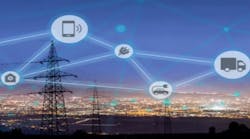As the world moves away from legacy centralized power generation and toward more renewable, distributed electricity generation and microgrids, monitoring and control technology is playing a larger role in our power-generation process. In the past, power flowed in only one direction—from centralized production facilities to the grid and finally to our homes and businesses. Now, with distributed-energy resources that include rooftop solar arrays and other small, locally owned power generation technologies, power can flow between individual sites and the grid in two directions. Monitoring and control technology enables this two-way communication between distributed-energy sources and local power grids.
According to Statista, in 2025, the global smart grid market is forecast to surpass $50 billion, and grow at a compound-annual growth rate (CAGR) of 17.4% until 2028, to reach roughly $130 billion. As the world transitions from the traditional grid to the smart grid, communication and monitoring capabilities are critical. This includes voltage monitoring, frequency monitoring and constant monitoring of energy production and transmission. Monitoring and communications between distributed-energy resources also helps smart grid systems determine where and when to place power.
Benefits of smart-grid technology
The shift to smart grids can create better reliability and more efficient power. The grid is an old mechanical system, and when it is supercharged with electronics and controls it introduces more opportunities for modern power use. Smart systems can direct better usage of power—sending the correct amount of power exactly where it is needed at precisely the right time. With fluctuating demand for power, in addition to fluctuating inputs of power from renewable sources, smart-grid systems can help utilities efficiently and effectively manage the flow of power through the grid.
The smart grid can bring positive changes to how we use power, but it requires sensitive computing equipment to do so. Computing technology deployed in renewable generation and microgrid control is often exposed to harsh environments. Rain, wind, sand and more can cause disruptions to this equipment that regulates two-way power generation and communication between smart-grid deployments.
Luckily, many of the challenges of protecting sensitive monitoring and control equipment have already been solved in other industries that have gone through a similar transition: manufacturing and telecommunications. We can utilize the protection equipment used in those spaces, as well as the experience gained from the industrial and telecommunications industry 4.0 revolution, for outdoor smart grid applications. This could be a major driver of velocity for accelerating smart grids and renewable energy while improving safety, improving reliability and increasing efficiency in this rapidly growing industry.
The connection and protection equipment that has been developed for telecommunications and industrial has been designed to excel in harsh environments while ensuring proper protection and connectivity of sensitive automation and communication equipment. This includes physical security, and protection from heat and vibrations as well as dust and other contaminants. The communication and control devices that are necessary in smart manufacturing, 5G rollout and telco enhancements are similar to the ones needed for smart-grid development. The enclosures that protect these components require communication capabilities through the enclosures, for instance, as well as similar ratings for protection of the enclosed elements and their ability to transmit signals.
Surge protection is key
Surge protection is also critical in both applications. Wiring going in and out of enclosures, and the antennas mounted to the enclosures, need to be protected with reliable surge-protection devices so that any potential fault currents do not damage the essential components contained within. Physical security is also critical for these enclosures, both in terms of access control and durability. Enclosures need to be sturdy enough that people cannot break in and steal components, and utilities and manufacturers both need visibility into who has accessed equipment—preferably remotely.
There are some additional considerations that are more specific to smart-grid applications, but telecommunications providers have begun to solve these challenges as well. For instance, smart-grid components—like telco installations—are often placed outside, exposing them to greater heat, water and wind. Smart-grid components also need well-designed lightning-protection systems and reliable grounding and bonding to keep grid components safe.
Applying lessons learned for a more sustainable & electrified world
The expertise we have gained while producing equipment that supports the transition to smart manufacturing and 5G infrastructure can help inform our work as our grids continue to transform. With decarbonization goals, the growth of renewable energy and distributed-energy resources and the electrification of everything, our grid needs to become smarter in order to support the demands of the future.
The lessons in physical protection, access control, surge protection and security that we learned in other industries help accelerate this shift while improving protection equipment for the smart grid. In turn, the work we do on the smart grid will inform our ability to rise to the next challenge as we build a more sustainable and electrified world.


